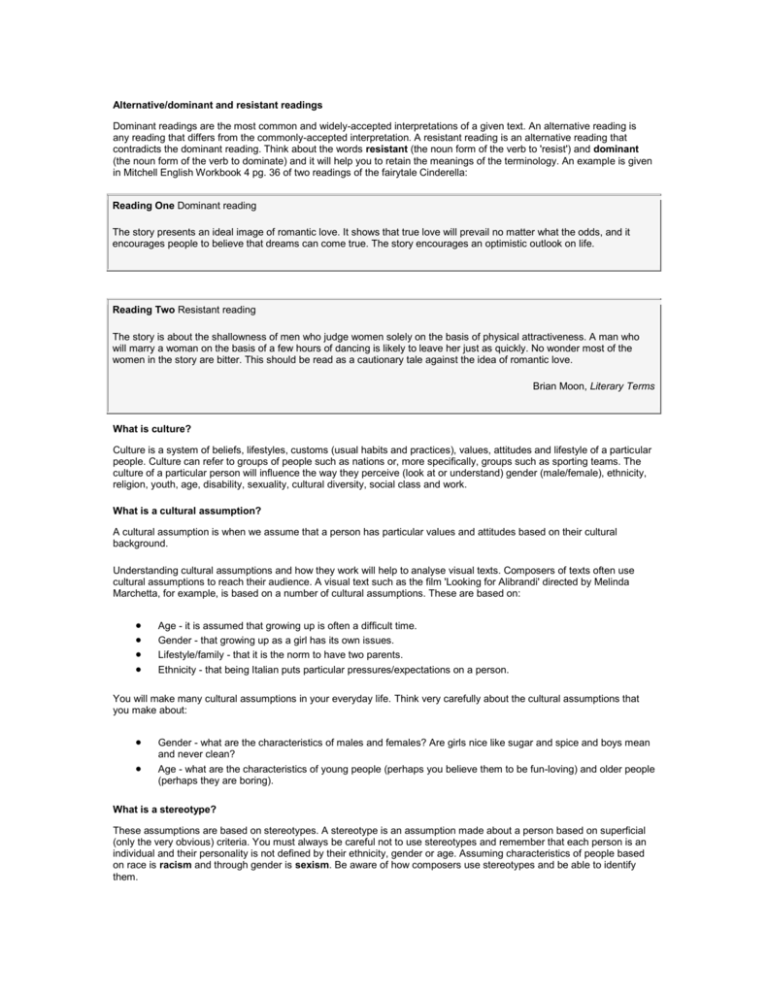Alternative/dominant and resistant readings
advertisement

Alternative/dominant and resistant readings Dominant readings are the most common and widely-accepted interpretations of a given text. An alternative reading is any reading that differs from the commonly-accepted interpretation. A resistant reading is an alternative reading that contradicts the dominant reading. Think about the words resistant (the noun form of the verb to 'resist') and dominant (the noun form of the verb to dominate) and it will help you to retain the meanings of the terminology. An example is given in Mitchell English Workbook 4 pg. 36 of two readings of the fairytale Cinderella: Reading One Dominant reading The story presents an ideal image of romantic love. It shows that true love will prevail no matter what the odds, and it encourages people to believe that dreams can come true. The story encourages an optimistic outlook on life. Reading Two Resistant reading The story is about the shallowness of men who judge women solely on the basis of physical attractiveness. A man who will marry a woman on the basis of a few hours of dancing is likely to leave her just as quickly. No wonder most of the women in the story are bitter. This should be read as a cautionary tale against the idea of romantic love. Brian Moon, Literary Terms What is culture? Culture is a system of beliefs, lifestyles, customs (usual habits and practices), values, attitudes and lifestyle of a particular people. Culture can refer to groups of people such as nations or, more specifically, groups such as sporting teams. The culture of a particular person will influence the way they perceive (look at or understand) gender (male/female), ethnicity, religion, youth, age, disability, sexuality, cultural diversity, social class and work. What is a cultural assumption? A cultural assumption is when we assume that a person has particular values and attitudes based on their cultural background. Understanding cultural assumptions and how they work will help to analyse visual texts. Composers of texts often use cultural assumptions to reach their audience. A visual text such as the film 'Looking for Alibrandi' directed by Melinda Marchetta, for example, is based on a number of cultural assumptions. These are based on: Age - it is assumed that growing up is often a difficult time. Gender - that growing up as a girl has its own issues. Lifestyle/family - that it is the norm to have two parents. Ethnicity - that being Italian puts particular pressures/expectations on a person. You will make many cultural assumptions in your everyday life. Think very carefully about the cultural assumptions that you make about: Gender - what are the characteristics of males and females? Are girls nice like sugar and spice and boys mean and never clean? Age - what are the characteristics of young people (perhaps you believe them to be fun-loving) and older people (perhaps they are boring). What is a stereotype? These assumptions are based on stereotypes. A stereotype is an assumption made about a person based on superficial (only the very obvious) criteria. You must always be careful not to use stereotypes and remember that each person is an individual and their personality is not defined by their ethnicity, gender or age. Assuming characteristics of people based on race is racism and through gender is sexism. Be aware of how composers use stereotypes and be able to identify them. Composers of visual texts will also use the cultural assumptions of their audience in more subtle (less obvious) ways. For example, what does the colour red mean to you? You may think of things such as danger, stop, love and passion. When the composer of a visual text uses red they are perhaps trying to make you think of these things. So, a stop sign or traffic light that is red tells you that you should stop. A warning sign that is red informs you of danger. Typically it is assumed in Australia, and many Western countries around the world, that the following colours signify the following things: Red: anger, passion, danger, stop White: peace, purity, cleanliness, life Black: death, sickness, evil Green: go, nature, happiness Blue: peace, serenity, boys Pink: love, girls This of course is not exhaustive - there are many, many more. When you approach a visual text remember that the use of colour is an attempt to communicate through cultural assumptions. It is important to be aware that different cultures attach meaning to colours in different ways. In China red is a colour that has connotations of happiness. Significantly, the traditional colour for Chinese brides to wear is red. Notice also that red is the dominant colour on the Chinese flag. The colour green dominates the flags of many Muslim countries and this is because green represents Islam. These differences in meaning can have a significant impact on visual images. Consider what an advertisement washed with red might mean in Australia and what it might mean in China. An Australian responder is positioned to see anger or danger whereas in China the responder is positioned to see happiness. More discussion on the use of colour in visual texts is included in Chapter 2 of 'Required Skills and knowledge: Language Features and Techniques'. Using cultural assumptions to analyse a text Refer to Text One Text One is a visual text that demonstrates stereotypes. The girl in the left is stereotypical because she fits the cultural assumption that teenage girls use telephones. Also, the composer has used the pink school bag to further highlight her girlishness. Is it only girls who use telephones? Do all girls wear/use pink? The boy in the right is kicking a football. This is a stereotypical image because it is culturally assumed that all boys like sport. Further, the boy is wearing blue which is the culturally assumed colour for boys. In this unit; It is important to be aware of the fact that each individual responder is positioned by their cultural background to attach meanings to particular visual cues. The interpretation of a text is often dependent upon the values that individuals place on age, gender, ethnicity and lifestyle as well as the connotations that arise from more subtle cues such as colours. An awareness of the use of these cultural assumptions will enable you, as a responder, to view visual texts more objectively and, as a composer, to express views more concisely.







